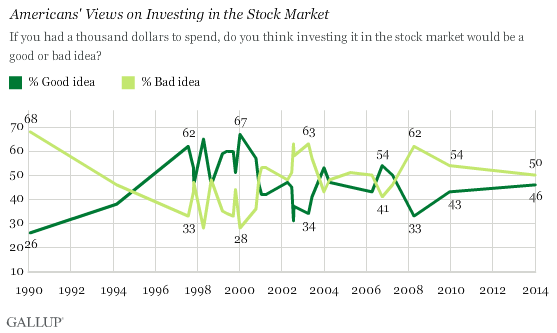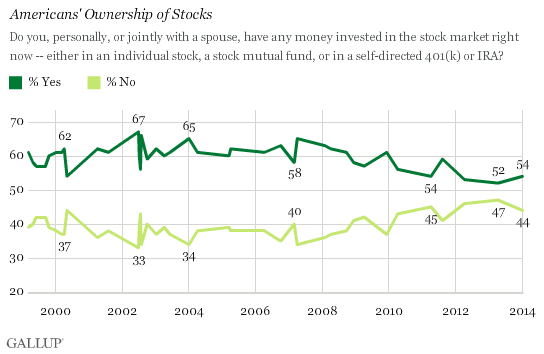WASHINGTON, D.C. -- Half of Americans say investing $1,000 in the stock market right now would be a bad idea, even though the Dow Jones Industrial Average and Standard & Poor's 500 index have recently hit record highs. Forty-six percent of Americans say investing $1,000 in the stock market would be a good idea.

Despite a Dow closing record high of 16,576 this past New Year's Eve, and an average that has stayed well above 16,000 throughout January, Americans appear skittish about pouring money into what appears to be a bull market, according to a Gallup poll conducted Jan. 5-8. In January 2000, when the Dow was at a then-record high of 11,500, Americans were much more likely to say investing in the stock market was a good idea than they are today. A record-high 67% of Americans that month said investing was a good idea.
After the onset of the 2008-2009 Great Recession, the percentage of Americans who believed investing in the markets was a bad idea swelled to 62%. While that percentage has dropped, Americans' confidence in buying stocks has clearly not returned to levels seen during the heady days of the early 2000s.
Stock Ownership Among Americans Still Near Record Low
Fifty-four percent of Americans now say they own stock, little changed from the 52% who said so last April -- which was the lowest in Gallup's 16-year trend of asking this question in its current format. Stock ownership is far lower than it was during the dot-com boom of 2000, when 67% said they owned stock -- a record high. While staying above 60% for much of the 2000s, the ownership percentage fell into the 50% range as the Great Recession took hold and has not yet rebounded. Despite economic booms and busts, however, a majority of Americans have maintained an investment in the markets in the past 15 years.

Although fewer Americans now own stocks, those who do, not surprisingly, are much more likely than non-owners to believe investing in the market is a good idea, 59% to 30%.
Bottom Line
During the dot-com boom of the late 1990s and early 2000s, confidence in investing in the stock market was higher than it is today and more people said they were invested in the market. With a federal budget surplus, low unemployment, and consistently high GDP growth, the record stock market of 2000 appeared to mirror the strong American economy.
The Dow is 5,000 points higher today than it was in 2000, but confidence in the markets is much lower, as is participation. The unemployment rate as reported by the Bureau of Labor Statistics is hovering around 7% in 2014, GDP growth is roughly 2% to 3%, and the government is mired in a large amount of debt. Given these factors, Americans may not believe that the current economy is as strong as the market suggests. Alternatively, they may believe the current market is inflated beyond reasonable measures. As 2014 unfolds, it will be interesting to observe whether the stock market continues its record pace and Americans regain confidence in investing or if a correction occurs, resulting in a decline in stock values.
Survey Methods
Results for this Gallup poll are based on telephone interviews conducted Jan. 5-8, 2014, with a random sample of 1,018 adults, aged 18 and older, living in all 50 U.S. states and the District of Columbia.
For results based on the total sample of national adults, the margin of sampling error is ±4 percentage points at the 95% confidence level.
Interviews are conducted with respondents on landline telephones and cellular phones, with interviews conducted in Spanish for respondents who are primarily Spanish-speaking. Each sample of national adults includes a minimum quota of 50% cellphone respondents and 50% landline respondents, with additional minimum quotas by region. Landline and cell telephone numbers are selected using random-digit-dial methods. Landline respondents are chosen at random within each household on the basis of which member had the most recent birthday.
Samples are weighted to correct for unequal selection probability, nonresponse, and double coverage of landline and cell users in the two sampling frames. They are also weighted to match the national demographics of gender, age, race, Hispanic ethnicity, education, region, population density, and phone status (cellphone only/landline only/both, and cellphone mostly). Demographic weighting targets are based on the March 2012 Current Population Survey figures for the aged 18 and older U.S. population. Phone status targets are based on the July-December 2011 National Health Interview Survey. Population density targets are based on the 2010 census. All reported margins of sampling error include the computed design effects for weighting.
In addition to sampling error, question wording and practical difficulties in conducting surveys can introduce error or bias into the findings of public opinion polls.
View methodology, full question results, and trend data.
For more details on Gallup's polling methodology, visit www.gallup.com.
